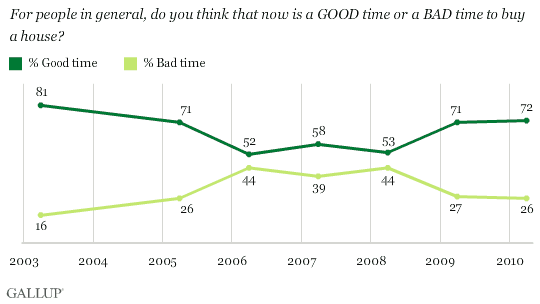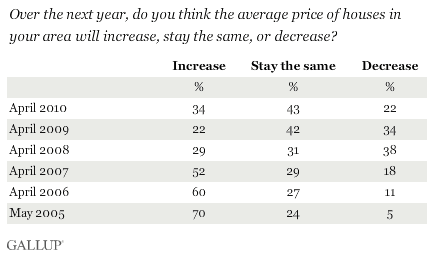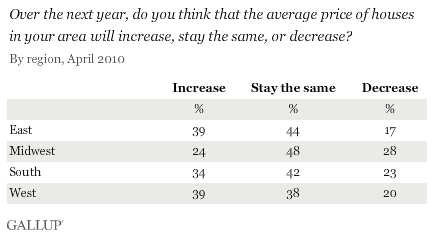PRINCETON, NJ -- Lower but stabilizing home prices combined with continued low mortgage interest rates have persuaded 72% of Americans that now is a "good time" to buy a house -- essentially the same percentage as a year ago, but up 19 points from 2008.

Better Price Expectations
More importantly, Americans' expectations about housing prices have improved markedly from last year -- potentially encouraging prospective buyers to take advantage of the current home-buying opportunity, and thereby making it easy for homeowners to sell. Thirty-four percent of Americans expect the average price of houses in their area to increase over the next year -- up 12 points from last year, and the highest such expectations in Gallup's monitoring since June 2007. When this is combined with the 43% expecting house prices to stay the same, a total of 77% of Americans see housing values in their area stabilizing or moving higher during the year ahead. To the degree that potential home buyers agree, this should significantly reduce their fear that the homes they buy could decline in value shortly after purchase.

Expectations for housing prices are best in the East and the West, followed closely by the South; they are poorest in the Midwest.

Commentary
Americans' recognition that now is a good time to buy a house is good news not only for everyone associated with the real estate business but also for the economy overall. Even better, it appears that in many local real estate markets, housing price expectations are for stable or increasing prices over the next 12 months, giving prospective home buyers in these areas another reason to buy now. Further, mortgage money from the federal government continues to be available at historically low rates through such agencies as Fannie Mae, Freddie Mac, and FHA/VA, although today's underwriting standards are more stringent than those during the housing boom.
While an overhang of foreclosures and distress sales continues to depress some areas, the basic problem facing housing in 2010-2011 is the same as that challenging the overall economy: jobs. Buying a home is the most important purchase and largest financial commitment most people make during their lives. For most Americans, it is hard to feel financially secure enough to make such a commitment in an economy in which 20% of the U.S. workforce is underemployed.
Results are based on telephone interviews with 1,020 national adults, aged 18 and older, conducted April 8-11, 2010. For results based on the total sample of national adults, one can say with 95% confidence that the maximum margin of sampling error is ±4 percentage points.
Interviews are conducted with respondents on landline telephones (for respondents with a landline telephone) and cellular phones (for respondents who are cell phone only).
In addition to sampling error, question wording and practical difficulties in conducting surveys can introduce error or bias into the findings of public opinion polls.
